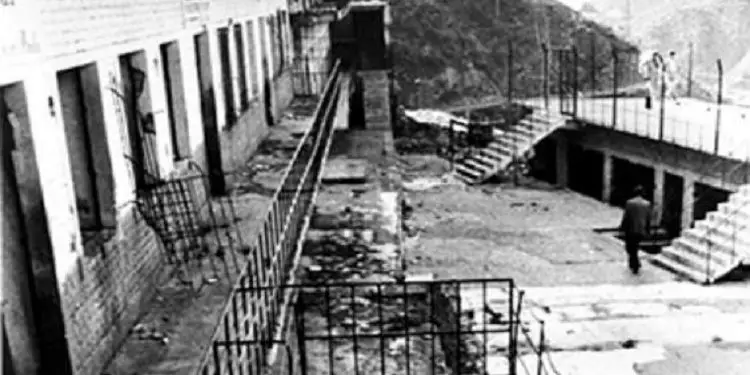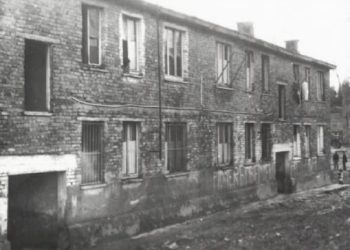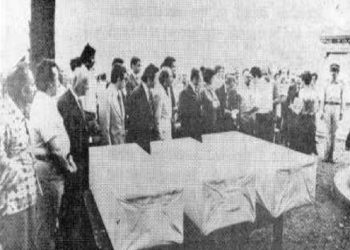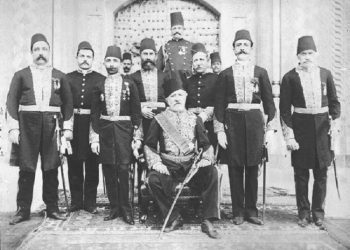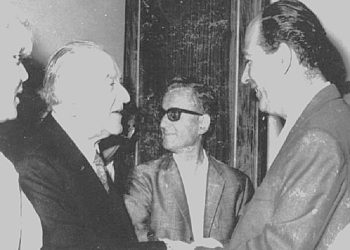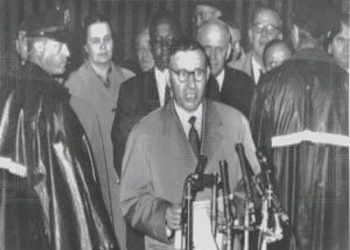From Agim Musta
Second part
Memorie.al / Agim Musta were born in the city of Gjirokastra in 1930, where his family originated from. He completed primary school in his hometown, while he finished high school in Tirana. After graduating from the Language-History Faculty, for a decade he served as a history teacher in the districts of Saranda, Kuçova and Tirana. In 1962, he was sentenced by the Military Court to 13 years in prison for anti-communist activity. After the 90s, Agim Musta engaged in writing and journalism, publishing in the press of the time, mainly on the subject of the communist regime of Enver Hoxha and his crimes. Similarly, during this period of time, he also published several books, such as: “Living Files”, 1994; “Who was Enver Hoxha”? (as co-author), 1996; “State Prisons”, 2000; “Things about communism in Albania”, 2001, “This is how it happened”, 2003, etc. The article that we have selected for publication is about one of the most hated characters of Enver Hoxha’s communist regime, Major General Nevzat Haznedar, the terrible and cruel investigator whom the author himself gave the epithet “The Black General”, as well as the article “Death Camps”, in which the still unsolved problem of finding the places where the victims of the communist dictatorship (from 1944 to 1990) were executed and the remains of over 6000 disappeared from that bloodthirsty regime is touched upon.
DEATH GROUNDS…!
How many people were executed in Albania during the years of communist terror, no one knows for sure, but the places where most of them were shot are known and named by the people “Death Ranges”. People kidnapped from the street on the outskirts of cities have been killed. Partisans were killed behind the arms, in the fields and valleys, buried by the villagers, without ever learning who they were! Innocent people have been killed, without a court decision, not recorded on any sheet, whose names appear alive in the civil status offices and no one knows where they are buried.
Citizens were killed trying to cross the border and their bodies were burned by the commandos of the border posts, sprayed with oil. People have been executed, on the edge of cliffs and their corpses have been thrown into the abyss, where even wild beasts cannot tread. Citizens have been shot by streams and rivers and their corpses have ended up in seas and lakes. Prisoners have died in the cells of the State Security and prisons, and their lifeless bodies have been thrown into the trash heaps of the cities.
During the years 1945-1948, in most cases, executions of “enemies” were carried out during the day, to instill terror in the citizens. Thus were executed in Tirana, in the month of May 1945, in the light of the sun, 17 former high dignitaries of the Albanian state, in the place called “Priest’s Hill”, a few meters to the right of the Porcelain Factory in Tirana.
Two days before the execution, the municipality workers, under the supervision of Security officers, had dug a pit, not very deep. Not even a week after the execution, the pit was discovered by grave robbers, who remembered that the important persons shot would have valuables, but left in disappointment, leaving the corpses uncovered in anger, as the killers, before shooting them, had robbed them of everything of value.
At the beginning of 1950, the Kobze Ministry of Internal Affairs ordered that every district Security branch should have a death range. There were several killing fields in Tirana, but the most important were by the Tërkuza and Erzen rivers. Hundreds of victims were executed there. Many of the corpses were taken from the murky waters of the rivers, or were eaten by birds, torn apart by wild animals. The catchphrase “Riverbank” became synonymous with death. When someone seriously cursed someone, he said: “I’m sorry for the river bank”!
Another execution ground in Tirana was near the Farka Bridge, on the Erzen River. Here is what my fellow sufferer, Nuri Stepa, (who has been in Spaç for many years and one of the organizers of the revolt in May 1973), who worked as a driver before he was sentenced, told me:
“I was traveling from Elbasan to Tirana, with the car loaded with olives. Before crossing the Farka Bridge, a policeman signaled me to stop and turn off the lights. I carried out the order and foresaw that something extraordinary was about to happen across the bridge. It was 11:00 at night. Although the moon was dim, across the bridge I could make out the contours of a Security “GAZ” and the auto-jail. Several people got off from “GAZ” and two people from the auto-jail sat down on the ground, being held by the arms by the policemen. Behind them, from the door of the auto-prison, they threw a third person on the ground, like a bag of salt, and dragged him by the legs.
He would probably have died during the transport by car, from a heart attack. In Zallishte, near the foot of the bridge, the two victims were executed by shooting them in the back of the head. Then the three corpses were kicked and thrown into a pit, near a thicket near the bridge. On top of the corpses, they threw something white, like lime dust. With a shovel, they threw some sand and gravel and left for the cars.
“GAZ” and the auto-prison turned towards Tirana, and the policeman, who was at the tail end of the bridge, got on the motorbike and started towards Tirana. I was so shocked by the macabre execution I saw that night that my hands were shaking when I gripped the steering wheel. Ten years have passed since that night and that scene remains in my memory as if it had happened last night.”
In the years of pluralism, many skeletons of shot people were found by the river Erzen, like the pit of 22 executed near the Beshiri Bridge, 12 km. in the south-west of Tirana, in February 1951, on the occasion of the so-called “incident” at the Soviet Embassy.
In Tirana, executions were also carried out at Ura e Sharkë, near Vora, in the tunnels of Qesaraka, on Malin me Gropa, near Ura e Brari and in some other place, which has not been identified to date. In Shkodër, the most important anti-communist bastion in Albania, Zalli i Kiri, from Bardhaj to the Kir river bridge, was designated as the place of execution. Hundreds of innocent people were executed in that cursed place, especially during the years 1945-1946, after the “cleansing operation” in the Great Highlands and the failure of the Postriba Uprising.
Executions were also carried out along the banks of the Buna River, near the Cement Factory, where often, during the rains, the buried corpses came to the surface, or were taken by the waves of the river. There have been cases where corpses have been left on the surface, without being buried, thrown on top of each other, as happened after the failure of the Postriba Uprising. This was done on purpose, in order to terrorize the residents of Shkodra. The expression “Take them to Zall te Kiri” became proverbial in Shkodër and symbolized death by bullet.
In Vlorë, the killing fields were located at “Bishti i Kalldrëm”, along the Vlorë-Kaninë road, in Hambare, near the Brick Factory and near a small bridge, by the national road, without going to Qafa e Koçiu. That bridge was called by the people of Vlora, “Ballist Bridge”. There, several hundred gunmen, convicted and unconvicted, were executed by the “people’s courts” of the communist dictatorship.
Even to this day, every honest Albanian who passes near this bridge remembers those men who were killed, for the sole fault of loving Albania.
In Gjirokastra, the executions were carried out in “Sheshin e Zinxhirire” and in Buduk, by the Drino river.
In Berat, the killing fields were located in Uznovë, as well as near Moravë village, by the Osum river.
In Durrës, executions were carried out in Porto-Romano and Bisht i Palla.
Here is what the fellow sufferer, Dervish Sulo, former prosecutor of Durrës, told me during the fifties:
“Those sentenced to death were executed in Porto-Romano. Once there was a factory for leather processing and there were many pits, where they had thrown leather waste, decomposed by acids. So, it was not necessary to dig new pits for the corpses of the executed. We brought the “GAZ” close to a pit, took down the man to be executed, placed him in front of the searchlights of the auto-jail, tied hand and foot, and executed him from behind, with a machine gun or a revolver.
When the person to be executed was important, we also took the doctor of the Department of Internal Affairs with us, to make a written statement about the person being annihilated. In most cases, the doctor signed the next day, without coming to the death row. When the person who was going to be executed was physically strong and too aggressive, in order not to cause trouble, he was “dry executed” inside the cell, shooting him behind the head with an iron crowbar and without doing so, either doctor, they took him to the place of execution.
After the murder, I was called as the branch’s prosecutor and doctor, for the drafting of the execution report, which was allegedly drawn up in the death range of Porto-Romano. Late at night, the corpse was thrown into the pits of Porto-Romano and immediately absorbed by the waste of the factory. Within a short time, it decomposed completely.”
According to the former general of the State Security, Halim Xhelo, (who was imprisoned in 1965 and after a few years he was hanged in the prison-hospital of Tirana), after 1948, for the disappearance of the corpses of executed people, it was used slaked lime, which over time decomposed not only the corpse, but also the bones of the victim. Halim Xhelo claimed that many corpses of murdered people were used as cadavers in the Faculty of Medicine at the University of Tirana and were sold outside Albania, to university hospital clinics.
In the prison-hell of Burrel, the “frontline” of Albanian intellectuals, during the years 1946-1990, more than 350 prisoners died, most of who were prominent intellectuals, graduates of the best universities in America and Europe. Every prisoner who died of hunger, disease, cruel treatment, was wrapped in an old blanket and thrown into a pit, located a few tens of meters behind the prison, near a cherry tree. The pit was covered with beams and planks and a thin layer of soil was placed over them.
Whenever a prisoner died, his corpse was taken out of the prison after dark and thrown into the common pit. A quantity of quicklime powder was thrown over the corpse.
The cherry tree, this wonderful tree, which the Japanese keep as a symbol of happiness, for the prisoners of Burrell and for their families, became a symbol of death. The fame of Burrel’s cherry crossed the barbed wire borders of Albania and became an inspiration for a Hungarian filmmaker who escaped to the West, for the realization of a feature film with the title “Cherry”.
Unfortunately, in Albania, the “Cherry” of Burrel prison is not even mentioned by our historians and artists. After the closing of the Burrell prison in 1990, in order to eliminate all traces of crime, the bulldozer leveled everything behind the prison, leaving no trace of the common pit of corpses.
In the years of pluralism, the families of the victims tried in vain to find even a bone of their relatives who died in that cruel prison.
In the Korça District, in the Stream of Shipskë Township, in the years of pluralism, dozens of human corpses were found, executed by the communists during the years 1943-1944. In the limbs of the skeletons, rusty nails are clearly visible, which clearly shows that the victims, before being executed, were cruelly tortured and nailed, like Christ on Golgotha.
In the Maliqi Marsh, in the district of Korça, for the drying of which during the years 1946-1950, several thousand political prisoners worked, those who died from hard work, from torture and diseases, were not buried, but thrown into swamp scum.
In the autumn, when the prisoners were sent to the prisons from which they had come, the torrential rains that came, carrying with them the mud of the swamp and the decomposed corpses came to the surface. They were attracted by the dogs of the villages around the marsh, becoming a terror to the villagers and the subject of ludicrous legends. In the prison camp of the Bulqiza mine, during the years 1947-1957, several hundred political convicts worked, in addition to ordinary prisoners. They removed them from Bulqiza when the Hungarian revolution broke out, fearing a mass revolt by the prisoners.
In the prison camp of Bulqiza, during the 43 years of exploitation of the mine with prisoners, more than 700 people have died. Suffice it to mention, that one day in 1969, from the collapse of a gallery, 17 prisoners died. For those unfortunates, not a word was said during the red dictatorship. The “necropolis” of Bulqiza, the largest of Albania’s prison camps and prisons, was razed before the communist coup d’état.
In order to preserve the historical memory of the Albanian people, the burden falls on the municipal councils to identify the polygons of death and place commemorative plaques in those places, but when will such a thing be done?! Memorie.al







